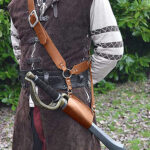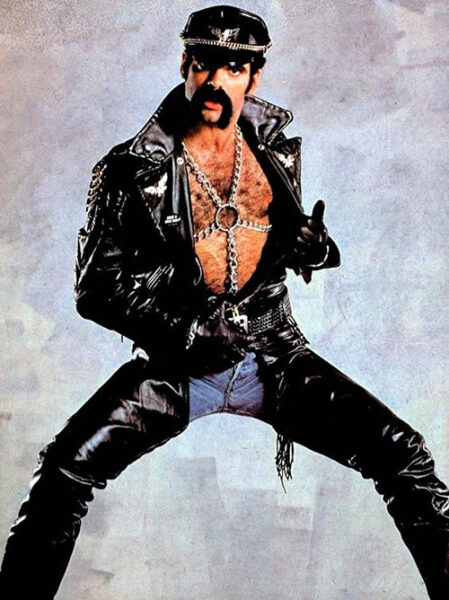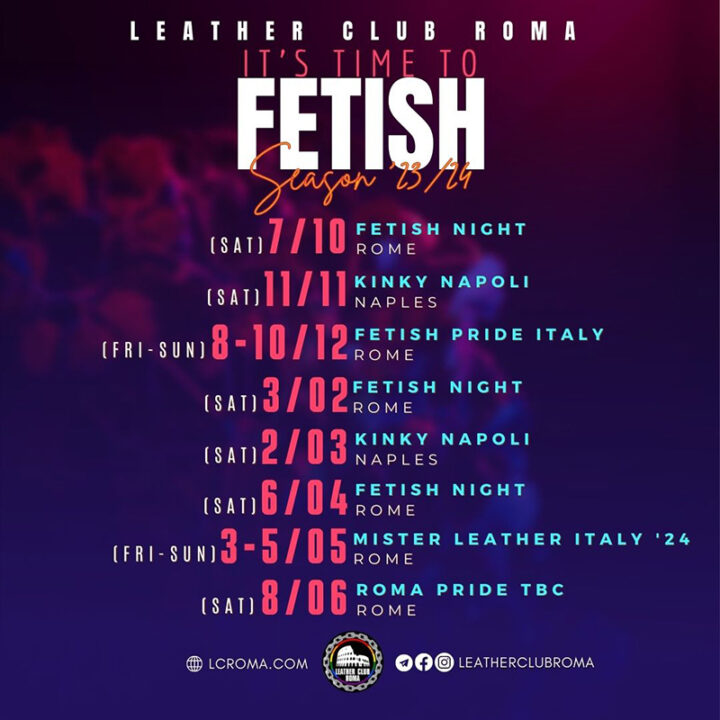History and evolution of the leather harness
Origins
The origins of the harness can be traced back to ancient civilizations that utilized leather (a flexible and durable material) for military purposes and to control animals.
Even today, leather harnesses are used as horse harnesses and headstalls, and more rarely, as full-body harnesses for attaching vehicles to animals (it’s interesting to note that another iconic piece of leather and fetish clothing, the chaps, has its origins in the world of horse breeding).

Reconstruction of a Medieval Leather Harness
The use of leather in the military context has a long tradition dating back thousands of years; whether combined with metal plates and chainmail or not, leather has been used to create armor for soldiers at least until the spread of firearms (when it became less effective in stopping or countering projectiles).
Aside from constructing complete armor, leather has been employed in the military as a supportive element for protections (usually made of metal) and/or to carry weapons (swords, daggers, and more), thus approaching a more “modern” usage.
A rather common use is that of a leather strip supporting a belt (passing diagonally over the shoulders) to prevent the belt from sliding down (especially when carrying attached objects or weapons). This practice remains in use to this day (common, for example, in many uniforms of World War II) and has given rise to another iconic item in the fetish world, the “Sam Browne” belt.
The use of leather strips as harnesses to support weapons has, furthermore, endured to the present day: axillary harnesses (made of leather or other materials) are still part of the equipment for many police forces and are used to keep the pistol (or other weapons) close to the body.
The emergence of the Harness in Gay Leather and Fetish Culture
The harness is now a widely prevalent clothing item, found in many variations within the gay community (and beyond). However, when, where, and why did it first appear?
When

Peter Berlin – Selfportrait with harness
There isn’t an “official birth” date for the harness; thus, we can attempt to establish a period within which it certainly appeared in the leather scene.
Research conducted by Mel Leverich in the archives of the Leather Archives & Museum in Chicago (as seen in “The Lost history of the leather harness“) shows that in the early 1970s, the harness is absent from the early catalogs of gay leather clothing and accessories. It first appears in 1972 (as a chain harness) and by 1976, it is widely present as a leather harness.
In Europe, Vivienne Westwood (an artist closely associated with punk and underground culture) showcased a harness in her “SEX” shop in London around 1975 (as seen in “A tribute to Jordan“).
The 1970s featured iconic figures in the Leather culture: Robert Mapplethorpe, Peter Berlin, and, of course, Tom of Finland. In Mapplethorpe’s “leather/fetish” works from the late 1970s, the harness is completely absent, as are the photographs of Peter Berlin (there’s only an self-portrait with harness where the harness is unconventional) Similarly, the harness is absent from all of Tom of Finland’s works until the late 1970s (it starts appearing in the 1980s, as seen in works like “Finlandinization 1″ from 1985).
In conclusion, all indications lead to the understanding that the harness, as we know it, appeared in the gay leather scene in the early 1970s.
Where
The answer to this question is quite straightforward and is contained in the references mentioned above: undoubtedly in the United States, but with a quick transition to Europe.
Why
There are many theories as to why the harness transitioned from military use to the gay leather culture in the 1970s in the United States:
- Some attribute it to the familiarity with military attire that was developed during World War II;
- Others mention the contact (also during World War II) with Japanese culture (samurai used leather harnesses to support their swords).
- Some theorize its initial use in the context of master/slave dynamics (especially chain harnesses), where the harness serves as a tool for the master to “bind” the slave.
The Spread within the Gay Leather Community

Glenn Hughes of the Village People (in stage attire)
It is during the 1980s that the harness began to spread within the gay leather and fetish community, becoming an identity symbol capable of conveying belonging to a community.
Traces of it can also be found in mainstream culture, such as in the clothing of Glenn Hughes of the Village People (who often wore a chain harness under his leather jacket), in the works of Tom of Finland from the 1980s (like the previously mentioned “Finlandinization 1”), and in Freddie Mercury of Queen who wore a harness on stage in 1979 (as seen in the center pages of Circus Magazine issue #205 in 1979).

Drummer magazine cover -Issue 10 – 1976
Starting from the iconic cover of the magazine’s issue #10 in 1976, Drummer (a prominent magazine for the gay leather community) increasingly featured images of men in harnesses on both covers and inside pages.
The galleries on the International Mister Leather website (especially those related to the early years of the contest ) testify to the rapid spread of harnesses as strong identity markers in the early 1980s.
Since then, the proliferation of harnesses within the gay leather community has not stopped. Its popularity is likely due to both its strong identity value and its affordability (especially when compared to other leather clothing items), ease of wear, and the image of strength and masculinity (and, in some cases, submission) it conveys.
Moreover, it’s an extremely versatile garment, allowing for infinite variations: full harnesses (sometimes linked to a cock ring), chest harnesses, shoulder harnesses; made of leather, rubber, or chains; worn bare-chested or over a white shirt (or even just glimpsed under a leather jacket).
In short: everyone has their own harness!
The New Millennium: Evolution and Mainstreaming

Dancefloor at the Australian gay techno party “Extra Dirty
With the arrival of the new millennium, the harness, thanks to its versatility, began to spread beyond the gay leather community. Becoming an (unwitting?) symbol of masculinity and appreciated for its ability (especially in the chest harness version) to accentuate and highlight the pectorals, the harness became a must-have at many gay disco parties, especially those featuring techno music.

Timothée Chalamet wearing a Louis Vuitton harness at the Golden Globes
In this process of diffusion, the harness took on new forms and colors: the colored bands that had spread in the 1990s following the hanky code evolved into entirely colored versions and even fluorescent harnesses that light up on the dance floors.
The harness embarked on a new path: no longer just an identity element within the gay leather community but a “simple” item of clothing. It first gained popularity within the broader gay community, then among the more inclusive queer community (as demonstrated by figures like Lady Gaga), and ultimately became a mainstream item, appearing in the collections of many fashion designers.
We are now far removed from the days when the harness was primarily an identity piece for the gay leather and BDSM communities. Nevertheless, its various versions (leather/BDSM, dance/techno, fashion) coexist and, when used in different contexts, showcase the versatility of a garment that originated millennia ago for completely different purposes.





